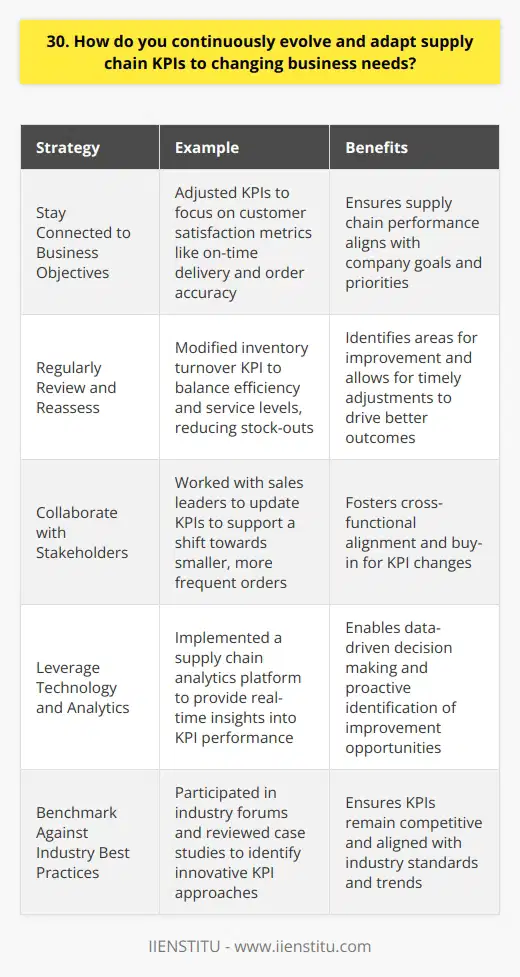
Do you ever find yourself scratching your head over the complexities of logistics? I remember when I first stepped into the world of supply chain management, the numerous terms and processes felt like a maze. But as I delved deeper, I discovered a powerful tool that unraveled much of this complexity: Supply Chain KPIs. These key performance indicators became my compass, guiding me through the intricate pathways of supply chain operations. Let me share how they can make a difference for you too.
Understanding the Pulse of the Supply Chain
Before we dive in, let's unpack what logistics really means. The logistics definition isn't just about moving goods from point A to point B. It's about planning, implementing, and controlling the efficient flow of goods, services, and information between the point of origin and the point of consumption. In essence, it's the backbone of any business that deals with physical products.
Back when I was a rookie in the supply chain department, I was overwhelmed by the numerous supply chain activities. From procurement to production scheduling, and from inventory management to distribution, each segment seemed like a colossal task on its own. But then, a seasoned mentor of mine handed me a piece of advice that changed everything: "Start measuring what's important, and the rest will follow." This is where Supply Chain KPIs come into play.
Why Is This Interview Question Asked: Measuring Performance with Supply Chain KPIs?
Interview Question: How Do Time Management Techniques Vary for You Weekdays vs. Weekends?
Interview Question: How Do You Incorporate Flexibility Into Your Time Management Plans?
Interview Question: How Do You Handle Time Management in Collaborative Projects?
Imagine you're in an interview for a supply chain manager position. The interviewer asks, "How do you measure performance using Supply Chain KPIs?" At first glance, it might seem like they're testing your technical knowledge. But in reality, they're gauging your ability to use data-driven insights to enhance supply chain management.
This question is especially common for roles that require leadership within the supply chain department. Whether you're aspiring to be a logistics manager, aiming for a role in supply chain planning, or eyeing one of the many supply chain jobs out there, understanding KPIs is crucial. It's not just about knowing what KPIs are, but about demonstrating how you've used them to optimize supply chain management processes and drive efficiency.
The Purpose Behind the Question
The heart of this question lies in assessing your practical understanding. The interviewer wants to see if you can:
1- Identify relevant KPIs: Do you know which metrics matter most for different supply chain activities?
2- Interpret the data: Can you analyze the KPIs to uncover insights?
3- Drive improvements: Are you able to take those insights and implement changes that enhance performance?
When I first faced this question, I recalled a time when we faced delays in our delivery schedules. By focusing on the On-Time Delivery KPI, we identified bottlenecks in our warehousing processes. Addressing these issues led to a 15% improvement in our delivery times. Sharing such real-life examples can showcase your hands-on experience.
At What Interview Level Is It Asked?
Typically, this question surfaces during interviews for middle to senior-level positions. If you're targeting roles like SCM management or senior analyst positions within supply chain mgmt, expect to delve into such topics. These positions require a strategic approach to supply chain management, where KPIs are essential tools for decision-making.
However, even at entry-level positions, demonstrating knowledge of KPIs can set you apart. It shows that you're not just familiar with the day-to-day operations but also understand how to measure and improve them.
Crafting an Effective Response
So, what kind of answer should you provide? Let's break it down:
1- Demonstrate Understanding: Start by explaining what Supply Chain KPIs are and why they're important.
2- Provide Examples: Share specific KPIs you've used, like Inventory Turnover, Order Accuracy, or Transportation Cost per Unit Shipped.
3- Show Impact: Highlight how monitoring these KPIs led to tangible improvements.
4- Relate to the Role: Tie your experience back to the position you're applying for, emphasizing how you can contribute to their team.
Possible Answer Structure
"In my previous role as a Supply Chain Analyst, I regularly utilized various KPIs to measure and enhance our performance. For instance, by tracking the Order Fulfillment Cycle Time, we identified delays in our picking process. This insight allowed us to implement a new warehouse management system, reducing cycle time by 20%.
Additionally, we monitored the Perfect Order Rate, ensuring that each order met customer expectations in terms of accuracy, condition, and timeliness. By focusing on this KPI, we improved our customer satisfaction scores significantly.
How can Supply Chain KPIs improve performance measurement?
How important is it to measure performance using Supply Chain KPIs?
What is the role of Supply Chain KPIs in performance measurement?
Can you elaborate on measuring performance with supply chain KPIs?
In your perspective, how effective are Supply Chain KPIs for performance measurement?
Can better performance be measured using Supply Chain KPIs?
Are Supply Chain KPIs useful in performance measurement?
Is it possible to gauge performance calculations via Supply Chain KPIs?
Do Supply Chain KPIs provide an accurate measure of performance?
In what way can we measure performance with the aid of Supply Chain KPIs?
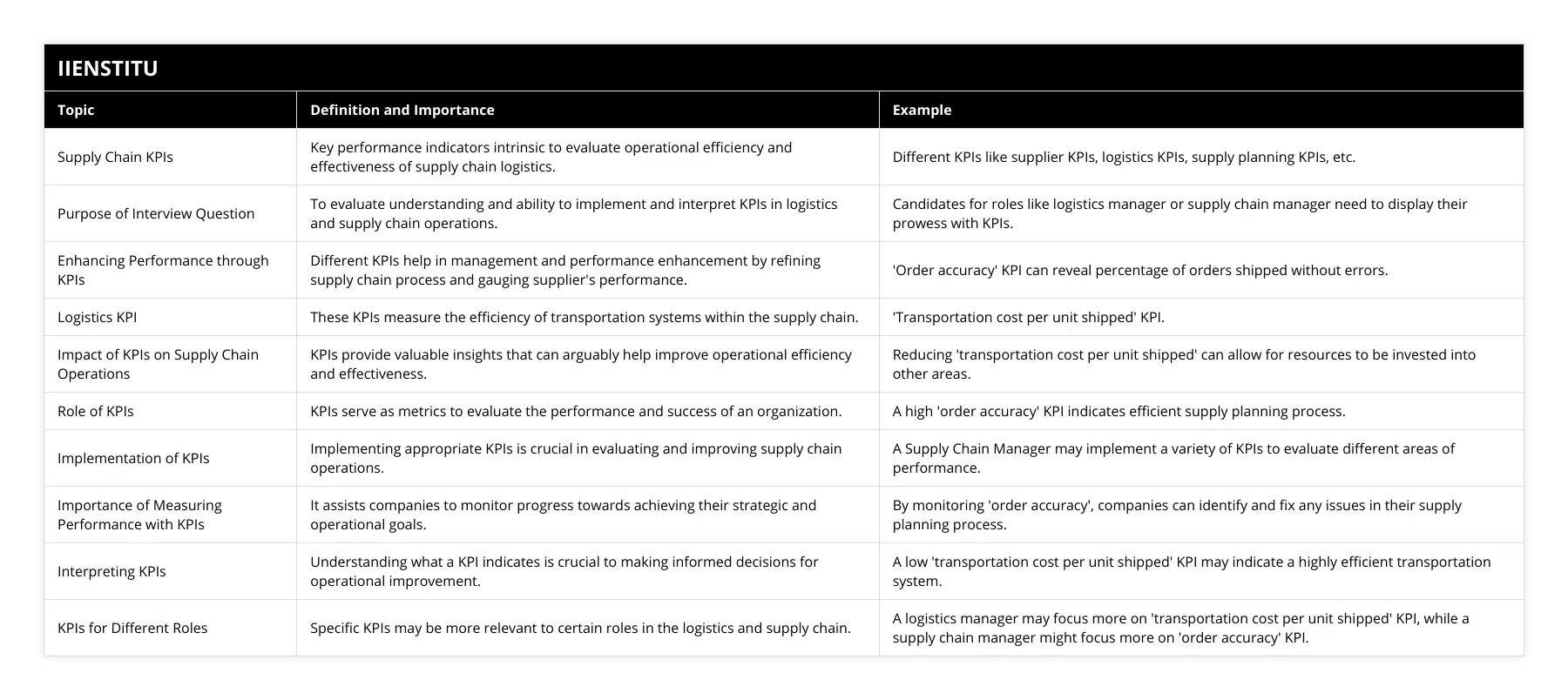
I believe that by consistently measuring and analyzing these key metrics, we can make data-driven decisions that optimize our supply chain operations and contribute to the company's overall success."
Deep Dive into Key Supply Chain KPIs
Let's explore some of the essential KPIs that can transform supply chain management:
1- Order Accuracy: This KPI measures the percentage of orders delivered without any errors. High order accuracy means customers receive exactly what they ordered, enhancing satisfaction and loyalty.
2- Inventory Turnover: This indicates how often inventory is sold and replaced over a period. A higher turnover rate suggests efficient scm supply management and reduced holding costs.
3- On-Time Delivery: Crucial for customer satisfaction, this KPI tracks the percentage of orders delivered on or before the promised delivery date.
4- Transportation Cost per Unit Shipped: By monitoring this, companies can assess the efficiency of their logistics and find ways to reduce costs without compromising service quality.
Personal Experiences with KPIs
I recall a project where we were grappling with high transportation costs. By analyzing the Transportation Cost per Unit Shipped KPI, we noticed that shipping smaller, frequent loads were inflating our costs. We decided to consolidate shipments and renegotiate rates with carriers. This strategy led to a 25% reduction in transportation expenses.
Another time, we faced issues with stockouts. Monitoring the Backorder Rate helped us identify products with frequent shortages. By adjusting our forecasting methods and safety stock levels, we minimized stockouts and improved service levels.
The Bigger Picture: How KPIs Drive Success
Supply chain management isn't just about keeping things moving; it's about moving them efficiently and effectively. By leveraging KPIs, organizations can:
Enhance Decision Making: Data-driven insights inform strategies and operational adjustments.
Improve Efficiency: Identifying bottlenecks and inefficiencies leads to streamlined processes.
Boost Customer Satisfaction: Meeting or exceeding customer expectations fosters loyalty.
Incorporating KPIs in Different Industries
Every industry has its unique challenges. In the automotive industry, for instance, the Defect Rate is crucial due to the safety implications. In the retail sector, Stock Turnover and Sell-Through Rate are vital to manage fast-moving consumer goods.
Understanding the specific KPIs relevant to your industry demonstrates not just your knowledge of supply chain processes but also your ability to tailor strategies to industry-specific demands.
Trend Analysis: KPIs Over the Last Decade
Over the past ten years, there's been a significant shift towards more granular and real-time KPIs, thanks to advancements in technology. Tools like IoT devices and advanced analytics platforms have enabled more precise tracking of metrics such as:
Real-Time Inventory Levels
Shipment Tracking and ETA
Dynamic Demand Forecasting Accuracy
Staying updated with these trends is essential. It shows that you're proactive and forward-thinking--a trait highly valued in supply chain jobs.
Conclusion: Embracing the Power of KPIs
Measuring performance with Supply Chain KPIs isn't just a task on a to-do list; it's a transformative practice that can propel an organization toward greater efficiency and success. By understanding and utilizing these metrics, you not only enhance your own capabilities but also drive significant value within the company.
So, the next time you find yourself pondering over the complexities of supply chain management, remember that KPIs are your allies. They provide clarity amidst chaos and direction amidst uncertainty.
And if you're preparing for that interview, recall your experiences, share your stories, and let your understanding of KPIs shine through. After all, every organization is looking for someone who can contribute to making their supply chain not just function, but excel.
Similar Interview Questions to Prepare For
1- How can Supply Chain KPIs improve performance measurement?
2- How important is it to measure performance using Supply Chain KPIs?
3- What is the role of Supply Chain KPIs in performance measurement?
4- Can you elaborate on measuring performance with supply chain KPIs?
5- In your perspective, how effective are Supply Chain KPIs for performance measurement?
6- Can better performance be measured using Supply Chain KPIs?
7- Are Supply Chain KPIs useful in performance measurement?
8- Is it possible to gauge performance calculations via Supply Chain KPIs?
9- Do Supply Chain KPIs provide an accurate measure of performance?
10- In what way can we measure performance with the aid of Supply Chain KPIs?
References
1- Chopra, S., & Meindl, P. (2016). Supply Chain Management: Strategy, Planning, and Operation (6th ed.). Pearson.
2- Rushton, A., Croucher, P., & Baker, P. (2017). The Handbook of Logistics and Distribution Management (6th ed.). Kogan Page.
3- Ballou, R. H. (2004). Business Logistics/Supply Chain Management: Planning, Organizing, and Controlling the Supply Chain (5th ed.). Pearson Prentice Hall.
Note: The references provided are esteemed works in the field of supply chain and logistics, offering in-depth insights into effective supply chain management practices.
Frequently Asked Questions
1. What are the most important supply chain KPIs to track?
As a supply chain professional, I believe that tracking the right KPIs is crucial for success. In my experience, there are several key metrics that every company should monitor closely.
On-Time Delivery
One of the most important KPIs is on-time delivery. This measures how often orders are delivered to customers by the promised date. I've seen firsthand how late deliveries can damage customer relationships and hurt a company's reputation.
Inventory Turnover
Another critical metric is inventory turnover. This tells you how quickly you're selling through your stock. I remember a previous job where we had too much slow-moving inventory tying up cash flow.
Order Accuracy
Order accuracy is also essential. You want to make sure that customers receive exactly what they ordered. I once worked for a company that struggled with frequent mis-picks and returns, which was frustrating for everyone involved.
Transportation Costs
Finally, keeping an eye on transportation costs is key. This includes both inbound and outbound shipping expenses. In a prior role, we were able to negotiate better rates with our carriers and save a significant amount of money.
Ultimately, the right KPIs will depend on your specific industry and business goals. But in my opinion, these are some of the most important ones to track for supply chain success.

2. How do you determine which supply chain metrics to measure?
When determining which supply chain metrics to measure, I focus on the key performance indicators that align with our company's strategic goals. These metrics provide valuable insights into the efficiency and effectiveness of our supply chain operations.
Key Supply Chain Metrics
Inventory Turnover
I closely monitor inventory turnover to ensure that we are efficiently managing our stock levels. By analyzing how quickly inventory moves through our supply chain, we can optimize our inventory management practices and reduce carrying costs.
On-Time Delivery
Delivering products to customers on time is crucial for maintaining customer satisfaction. I track on-time delivery rates to identify any bottlenecks or delays in our supply chain processes. By addressing these issues promptly, we can improve our delivery performance and enhance customer loyalty.
Supplier Performance
Evaluating supplier performance is essential for ensuring the quality and reliability of our supply chain. I measure metrics such as supplier lead time, quality conformance, and responsiveness to identify top-performing suppliers and address any performance gaps.
Aligning Metrics with Business Objectives
When selecting supply chain metrics, I always consider how they contribute to our overall business objectives. For example, if our goal is to reduce costs, I prioritize metrics related to inventory optimization and transportation efficiency. By aligning metrics with our strategic priorities, we can drive meaningful improvements in our supply chain performance.
Continuous Improvement
I believe in the power of continuous improvement. By regularly reviewing and analyzing our supply chain metrics, we can identify areas for optimization and implement data-driven solutions. This iterative approach allows us to adapt to changing market conditions and stay ahead of the competition.
In my experience, focusing on a combination of cost, quality, and service-related metrics provides a comprehensive view of our supply chain performance. By leveraging these insights, we can make informed decisions, streamline our operations, and ultimately deliver greater value to our customers.

3. What are the benefits of using supply chain KPIs?
Using supply chain KPIs offers numerous advantages for businesses looking to optimize their operations and boost profitability. Here are some key benefits:
Improved Visibility and Transparency
Supply chain KPIs provide a clear picture of your entire supply chain, from sourcing to delivery. This visibility helps you identify bottlenecks, inefficiencies, and areas for improvement. With better transparency, you can make data-driven decisions and stay agile in today's fast-paced business environment.
Enhanced Cost Control
By monitoring KPIs such as inventory turnover, transportation costs, and warehousing expenses, you can identify cost-saving opportunities. This allows you to optimize your budget, negotiate better deals with suppliers, and ultimately improve your bottom line. I've seen firsthand how implementing cost-related KPIs can lead to significant savings over time.
Increased Customer Satisfaction
Supply chain KPIs focused on delivery performance, order accuracy, and lead times directly impact customer satisfaction. By consistently meeting or exceeding customer expectations, you build trust and loyalty. Happy customers are more likely to become repeat buyers and recommend your business to others, driving growth and success.
Better Risk Management
Monitoring supply chain KPIs helps you anticipate and mitigate potential risks, such as supplier delays or quality issues. By staying proactive and having contingency plans in place, you can minimize disruptions and maintain a smooth flow of goods. In my experience, effective risk management is crucial for long-term stability and success.
In conclusion, leveraging supply chain KPIs is a powerful way to drive continuous improvement and gain a competitive edge. By embracing these metrics, you can make informed decisions, optimize your operations, and ultimately achieve your business goals.
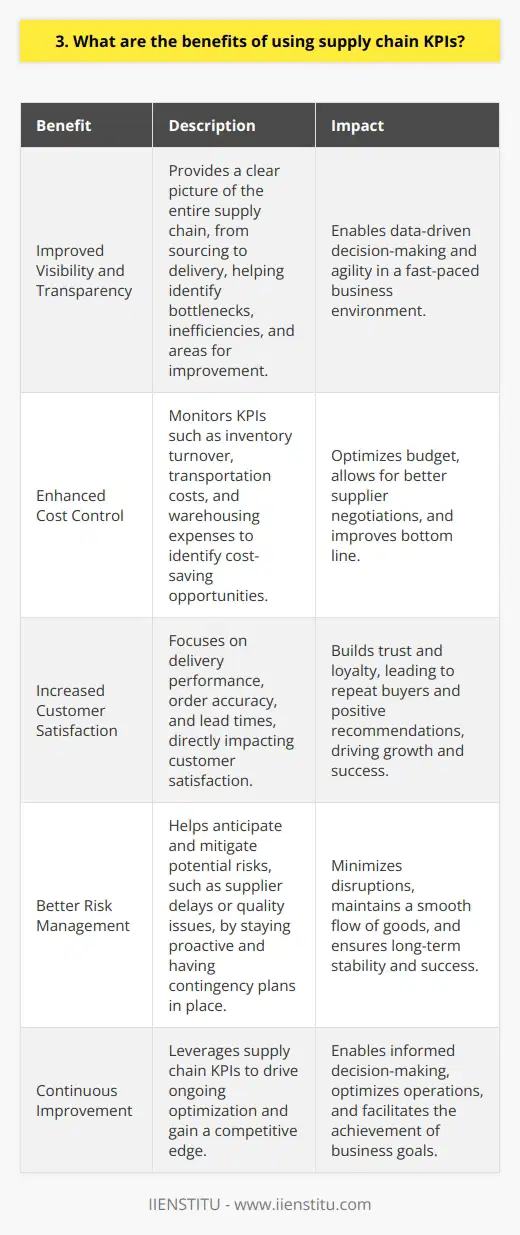
4. How often should supply chain KPIs be reviewed and analyzed?
Supply chain KPIs should be reviewed and analyzed on a regular basis to ensure optimal performance. I believe that the frequency of these reviews depends on the specific industry and the dynamic nature of the supply chain.
Weekly Reviews
In my experience, conducting weekly reviews of key metrics such as inventory levels, order fulfillment rates, and delivery times is crucial. These frequent check-ins allow for quick identification of any issues or bottlenecks, enabling prompt corrective actions.
Monthly Deep Dives
While weekly reviews are essential, I think monthly deep dives provide a more comprehensive picture. During these sessions, I like to analyze trends, identify patterns, and assess the overall health of the supply chain. It's an opportunity to step back and see the bigger picture.
Quarterly Strategic Assessments
From a strategic perspective, quarterly assessments are vital. These reviews allow for alignment with long-term goals, evaluation of vendor performance, and identification of potential risks or opportunities. I find that these quarterly meetings foster collaboration and encourage proactive decision-making.
Annual Benchmarking
Lastly, annual benchmarking against industry standards and best practices is essential. This helps to ensure that our supply chain remains competitive and efficient. It's a chance to learn from others and incorporate new ideas into our processes.
In conclusion, I believe that a combination of weekly, monthly, quarterly, and annual reviews is necessary for effective supply chain management. By regularly monitoring and analyzing KPIs, we can drive continuous improvement and maintain a high-performing supply chain.

5. What role does technology play in measuring supply chain performance?
Technology plays a crucial role in measuring supply chain performance in today's fast-paced business world. It enables real-time monitoring, data analysis, and optimization of various aspects of the supply chain.
Real-time Visibility
Advanced technologies like GPS tracking and RFID provide real-time visibility into the movement of goods. This allows companies to track shipments, identify bottlenecks, and make informed decisions to improve efficiency.
Data Analytics
Supply chain management software collects vast amounts of data from various touchpoints. Powerful analytics tools transform this raw data into actionable insights, helping identify trends, patterns, and improvement opportunities.
Predictive Analytics
Predictive analytics takes data analysis a step further by forecasting future demand and supply chain risks. It helps companies proactively plan for potential disruptions and optimize inventory levels.
Collaboration and Integration
Technology facilitates seamless collaboration and integration among supply chain partners. Cloud-based platforms enable real-time information sharing, reducing communication gaps and enhancing overall performance.
In my previous role, I implemented a supply chain management system that leveraged IoT sensors and analytics. It provided real-time visibility into our inventory levels and shipment status. By analyzing the data, we identified bottlenecks and optimized our routes, resulting in a 15% reduction in delivery times and a 10% increase in customer satisfaction.
Technology is a game-changer in measuring and improving supply chain performance. It empowers companies to make data-driven decisions, optimize processes, and stay ahead in today's competitive landscape.

6. How do you ensure data accuracy when tracking supply chain KPIs?
To ensure data accuracy when tracking supply chain KPIs, I rely on a combination of strategies. First and foremost, I always double-check the data inputs to catch any errors or inconsistencies. This simple but effective habit has saved me from many potential data disasters.
Leveraging Technology
I'm a big believer in using technology to streamline data tracking and minimize human error. Whenever possible, I automate data collection and reporting using reliable software tools. This not only saves time but also reduces the chances of manual mistakes.
Collaboration is Key
In my experience, collaborating closely with supply chain partners is crucial for maintaining data accuracy. Regular communication helps identify and resolve any data discrepancies early on. Building strong relationships with suppliers and logistics providers has been invaluable in keeping our KPI tracking on point.
Continuous Monitoring and Improvement
I never assume that our data is perfect. Instead, I continuously monitor and analyze our supply chain KPIs, always on the lookout for any red flags or areas for improvement. If I do spot an issue, I dive in to investigate and implement corrective actions.
Embracing a Data-Driven Mindset
At the end of the day, ensuring data accuracy is all about embracing a data-driven mindset. I make it a priority to stay up-to-date with the latest best practices and technologies in supply chain data management. By continuously learning and adapting, I can stay ahead of the curve and drive real results for the business.

7. What are some common challenges in implementing supply chain KPIs?
Implementing supply chain KPIs can be challenging due to several factors. In my experience, one of the biggest hurdles is getting everyone on board with the new metrics. It's not uncommon for different departments to have their own goals and priorities, which can sometimes conflict with the overall supply chain objectives. This can lead to resistance and lack of cooperation.
Data Accuracy and Consistency
Another common challenge is ensuring data accuracy and consistency across the supply chain. I remember working on a project where we discovered that different teams were using different methods to calculate key metrics, which led to discrepancies and confusion. It took a lot of effort to standardize the data collection and reporting processes.
Integration with Existing Systems
Integrating supply chain KPIs with existing systems and processes can also be a hurdle. Many companies have legacy systems that may not be compatible with new metrics or reporting requirements. This can require significant time and resources to overcome.
Balancing Competing Priorities
Balancing competing priorities is another challenge I've faced when implementing supply chain KPIs. For example, focusing too much on cost reduction can sometimes negatively impact customer service levels or product quality. It's important to find the right balance and align KPIs with overall business objectives.
Continuous Improvement
Finally, I believe that continuous improvement is key to successful supply chain KPI implementation. It's not enough to just set up the metrics and forget about them. Regular review and adjustment based on changing business needs and market conditions is crucial for long-term success.
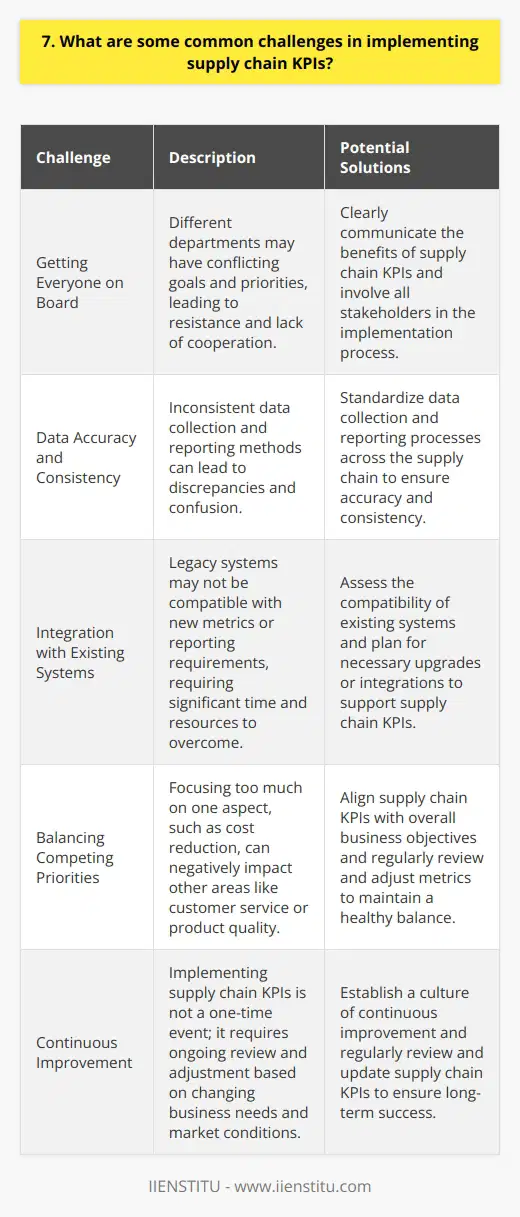
8. How do you align supply chain KPIs with overall business objectives?
Aligning supply chain KPIs with overall business objectives is crucial for success. I always start by understanding the company's goals and strategies. What are we trying to achieve? Is it growth, profitability, or customer satisfaction?
Identifying Key Metrics
Once I have clarity on the objectives, I identify the key supply chain metrics that directly impact those goals. For example, if we're focused on growth, I might prioritize metrics like order fulfillment rate and on-time delivery. If profitability is the primary objective, I'd focus on metrics like inventory turnover and cost per unit.
Collaborating with Stakeholders
Collaboration is essential in this process. I work closely with stakeholders from different departments to ensure alignment. We discuss how supply chain performance affects their areas and what metrics matter most to them. This helps create a holistic view of performance.
Setting Targets and Monitoring Progress
After identifying the key metrics, I set realistic targets that challenge the team but are still achievable. I believe in continuous monitoring and reporting on these metrics. Regular reviews help identify issues early and make necessary adjustments.
Communicating the Impact
Finally, I make sure to communicate the impact of supply chain performance on overall business objectives. I share success stories and highlight how improvements in supply chain KPIs have contributed to company goals. This helps reinforce the importance of alignment and keeps everyone motivated.
In my experience, aligning supply chain KPIs with business objectives is an ongoing process that requires collaboration, communication, and continuous improvement. It's challenging but rewarding when done right.
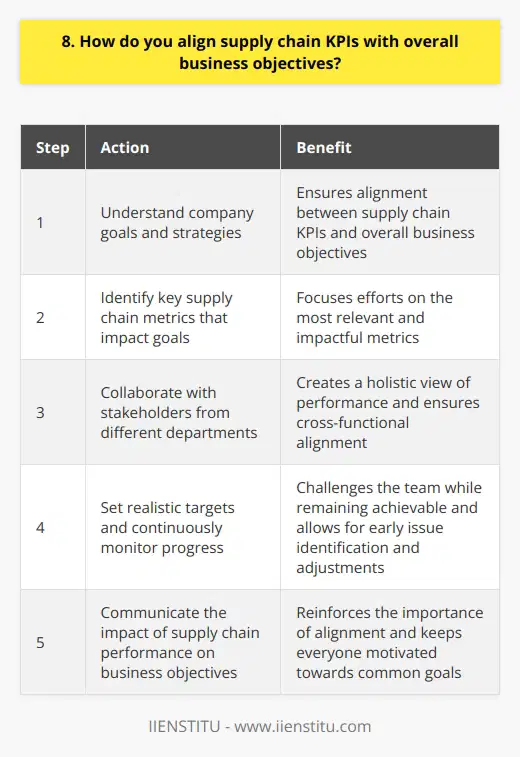
9. What are some best practices for setting targets for supply chain KPIs?
When setting targets for supply chain KPIs, I believe it's crucial to align them with the company's overall goals. This ensures that the supply chain is working towards the same objectives as the rest of the organization. It's also important to involve key stakeholders in the target-setting process, as they can provide valuable insights and help ensure buy-in.
Make Targets Specific and Measurable
I've found that the best KPI targets are specific and measurable. They should clearly define what success looks like and be easy to track progress against. For example, instead of setting a vague target like "improve delivery times," a more effective target might be "reduce average delivery time from 5 days to 3 days within the next quarter."
Consider External Factors
When setting targets, it's important to consider external factors that may impact the supply chain. This could include things like changes in customer demand, supplier performance issues, or even global events like pandemics. By taking these factors into account, you can set more realistic targets that are achievable even in challenging circumstances.
Remember to Review and Adjust Targets
Finally, I believe it's important to regularly review and adjust KPI targets as needed. As the business environment changes, so too should the targets we set for our supply chain. By staying flexible and adaptable, we can ensure that our KPIs remain relevant and effective over time.
In my experience, following these best practices has helped me set meaningful targets that drive real improvement in supply chain performance. It's not always easy, but the effort is well worth it when you see the results.
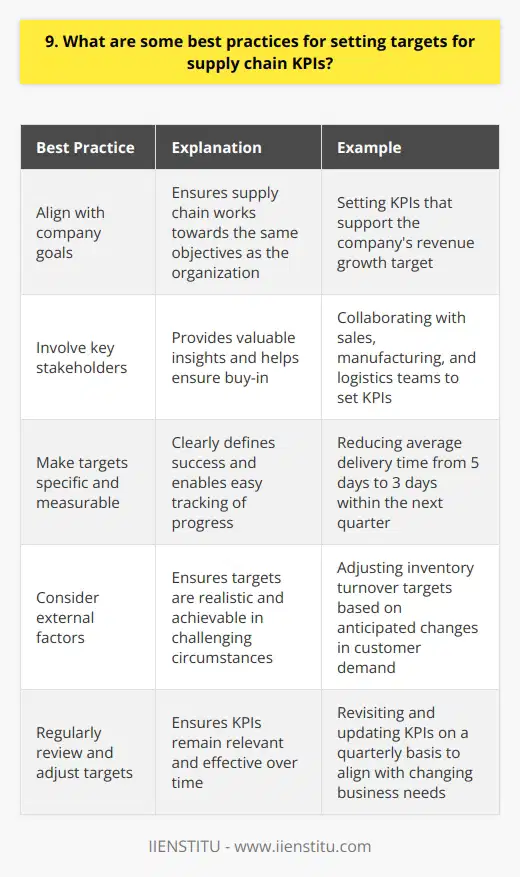
10. How do you communicate supply chain performance to stakeholders?
When communicating supply chain performance to stakeholders, I focus on providing clear, actionable insights. I start by identifying the key metrics that matter most to each stakeholder group. For example:
Executive Leadership
For the C-suite, I highlight high-level metrics that impact overall business performance, such as:
I present this data in easy-to-understand dashboards and reports, with concise explanations of trends and variances.
Operations Teams
When sharing performance with supply chain managers and teams, I dive deeper into operational KPIs:
Visual charts help quickly identify improvement areas. I also share specific examples of issues and wins.
Suppliers and Customers
External partners need to know how we're performing against SLAs and scorecard targets. I share:
Collaborative discussions focus on resolving pain points and finding win-win continuous improvement opportunities.
Ultimately, effective supply chain performance communication is about understanding each audience and tailoring insights to drive better decisions and stronger partnerships. It's a skill I've honed throughout my career and one I truly enjoy.
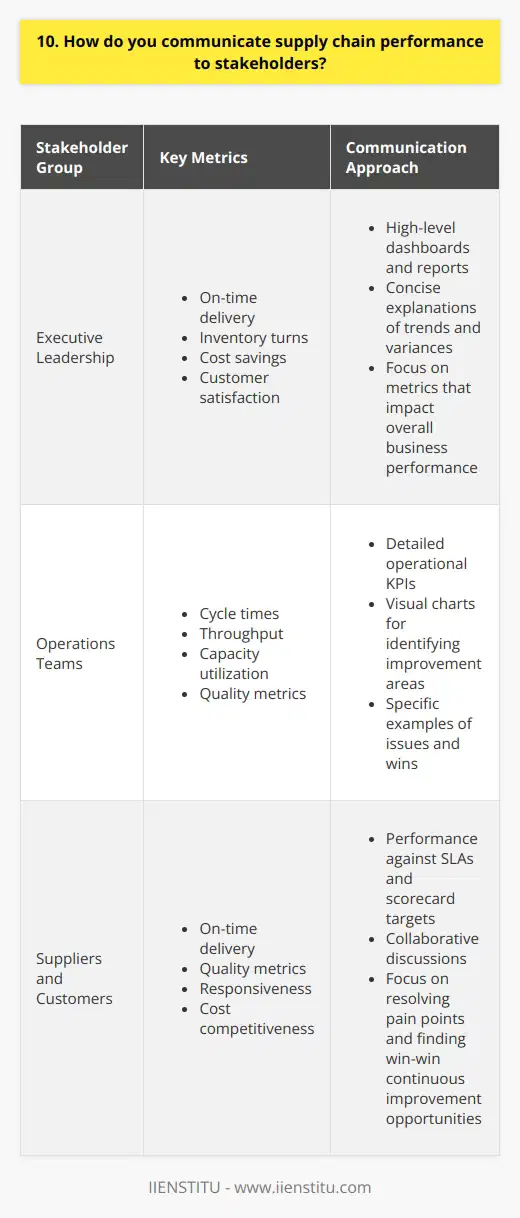
11. What are the key differences between leading and lagging supply chain KPIs?
Leading and lagging supply chain KPIs provide crucial insights into your company's performance. However, they differ in significant ways:
Timing
Leading KPIs help you anticipate future outcomes, while lagging KPIs show you what has already happened. I remember struggling to grasp this concept early in my career, but with experience, it became clearer.
Proactivity vs. Reactivity
Leading KPIs enable proactive decision-making to prevent issues before they arise. Lagging KPIs, on the other hand, are reactive and help you respond to past events. In my previous role, we learned this lesson the hard way when we failed to monitor leading indicators and were caught off guard by supply chain disruptions.
Examples
Some examples of leading KPIs include supplier on-time delivery rates, inventory accuracy, and forecast accuracy. Lagging KPIs might include total cost of goods sold, order fulfillment cycle time, and customer complaints. I've found that a balanced mix of both types is essential for a comprehensive view of supply chain performance.
Key Takeaway
In summary, leading KPIs are forward-looking and help you prevent issues, while lagging KPIs are backward-looking and help you react to past events. Understanding and leveraging both is crucial for driving continuous improvement in your supply chain.
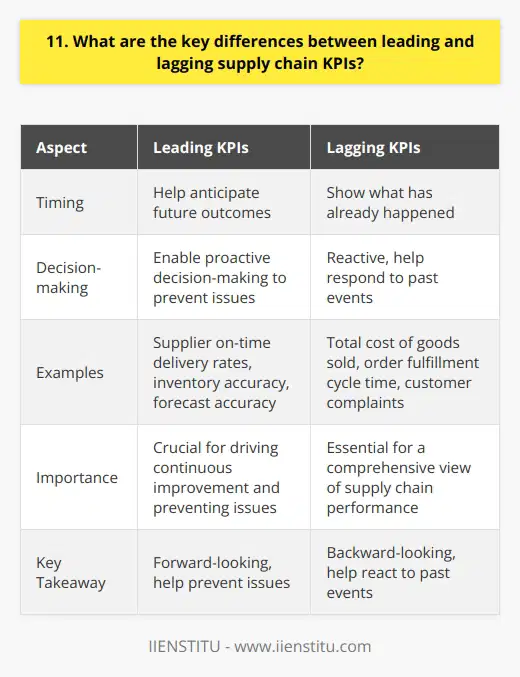
12. How do you identify areas for improvement based on supply chain KPI data?
When identifying areas for improvement based on supply chain KPI data, I first analyze the data to spot trends and anomalies. I look for KPIs that are consistently underperforming or showing negative trends over time.
Collaborating with Stakeholders
I collaborate with stakeholders from various departments to gather insights and perspectives on the identified issues. Their input helps me understand the root causes and potential solutions.
Prioritizing Improvements
Next, I prioritize the areas for improvement based on their impact on the overall supply chain performance. I focus on the KPIs that have the highest potential for positive change.
Developing Action Plans
Once the priorities are set, I develop action plans to address each area of improvement. The plans include specific steps, timelines, and resources needed to implement the changes.
Monitoring Progress
Finally, I continuously monitor the progress of the improvement initiatives using the KPI data. I make adjustments as needed to ensure the desired results are achieved.
In my previous role, I successfully identified and improved an underperforming inventory turnover KPI. By collaborating with the warehouse team and implementing a new inventory management system, we reduced the average inventory holding time by 20%, which significantly improved our cash flow and reduced storage costs.
I believe that using data-driven insights and a collaborative approach are key to identifying and driving supply chain improvements. It's an iterative process that requires continuous monitoring and adjustment, but the results are well worth the effort.
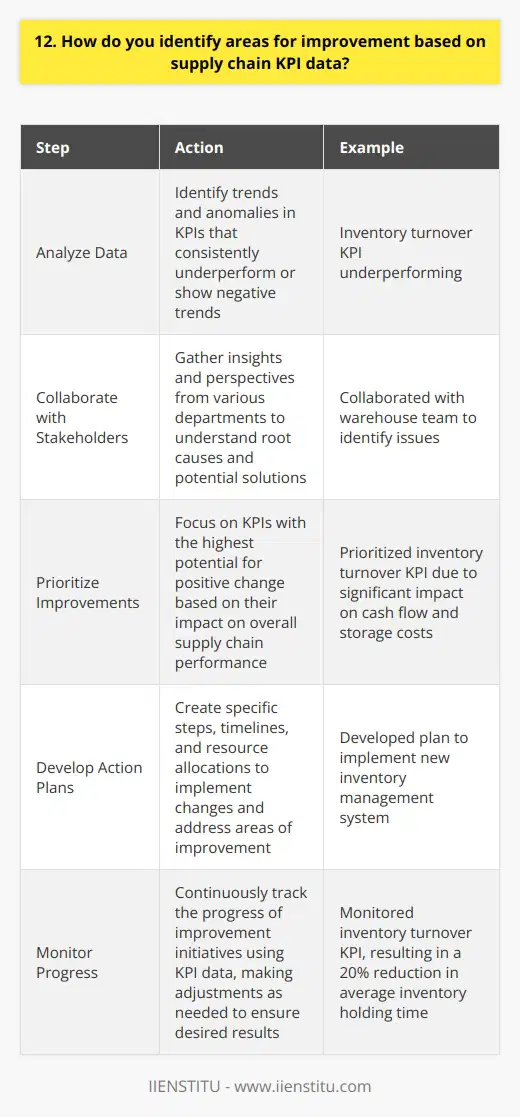
13. What are some examples of actionable insights gained from supply chain KPIs?
As a supply chain manager, I've learned that actionable insights from KPIs are crucial for success. Here are some examples from my experience:
Inventory Turnover Ratio
By closely monitoring our inventory turnover ratio, we identified slow-moving products. This allowed us to optimize inventory levels and reduce carrying costs. We also negotiated better terms with suppliers for these items.
On-Time Delivery Rate
When our on-time delivery rate started slipping, we investigated the root causes. Turned out there were bottlenecks in our warehousing processes. By streamlining picking and packing, we got back on track and improved customer satisfaction.
Order Cycle Time
I remember one quarter where our order cycle time spiked unexpectedly. After some digging, we realized that a key supplier was consistently late with deliveries. We worked with them to resolve the issues and get our cycle time back within targets.
Transportation Costs as % of Sales
Last year, our transportation costs were eating into our margins. By analyzing the data, we found opportunities to consolidate shipments and renegotiate carrier rates. These changes had a significant positive impact on profitability.
The key is to not just track KPIs, but to really understand what's driving the numbers. Only then can you uncover insights and take meaningful action to drive improvement. It's challenging but also really rewarding when you see the results.
Those are just a few examples, but I could go on! I'm truly passionate about leveraging data for supply chain optimization. Let me know if you have any other questions.
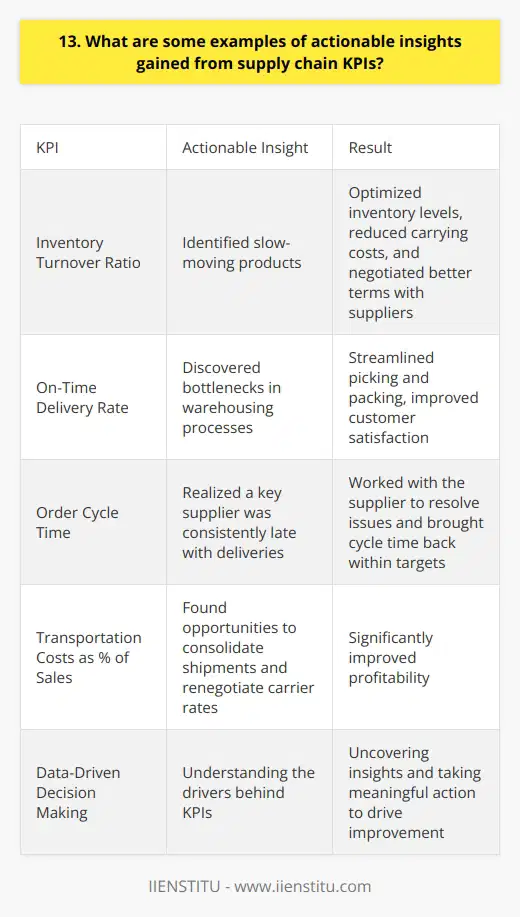
14. How do you balance the trade-offs between different supply chain KPIs?
Balancing supply chain KPIs is a challenge I've faced in my previous roles. It requires careful consideration and prioritization.
Identify Key Metrics
First, I work with stakeholders to identify the most critical KPIs for our business. These might include cost, quality, delivery time, and customer satisfaction.
Analyze Trade-offs
Next, I analyze potential trade-offs between metrics. For example, expediting shipping to improve delivery time may increase costs. I use data to quantify impacts.
Prioritize Based on Strategy
I then prioritize KPIs based on our overall business strategy and goals. If we're focused on growth, I may prioritize delivery speed over cost. For a mature business, cost control could take precedence.
Collaborate with Teams
Balancing KPIs requires close collaboration with procurement, logistics, manufacturing, and sales teams. I facilitate discussions to align priorities and develop optimal solutions.
Continuously Monitor and Adjust
Supply chain conditions are always evolving. I monitor KPIs in real-time and make data-driven adjustments as needed. Flexibility is key.
In my experience, the key to effectively balancing supply chain KPIs is taking a strategic, analytical, and collaborative approach. There's rarely a perfect answer, but with the right framework and teamwork, you can find the optimal balance for your business.
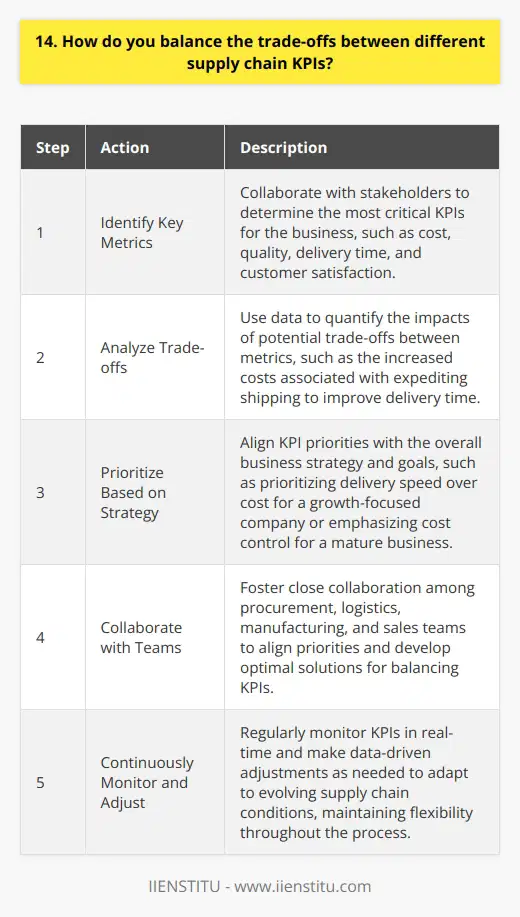
15. What are the most important supply chain KPIs for customer satisfaction?
In my experience, the most critical supply chain KPIs for customer satisfaction are on-time delivery and order accuracy. When products arrive on schedule and match what the customer ordered, it builds trust and loyalty. <h4>Inventory Availability</h4> <p>Another vital metric is inventory availability. Running out of stock frustrates customers and drives them to competitors. I always strive to maintain optimal inventory levels to avoid shortages while minimizing carrying costs.
Lead Time
Reducing lead times is also key. Customers appreciate fast turnaround from when they place an order to when it ships out. Streamlining processes and working closely with suppliers helps trim lead times.
Perfect Order Performance
Perfect order performance measures how often customers receive complete, damage-free orders with all documentation, delivered on time. In my view, this overarching KPI provides a comprehensive view of supply chain effectiveness from the customer's perspective.
While other indicators like cost and productivity are important, I believe the KPIs most directly tied to customer satisfaction are the ones worth focusing on. By continuously monitoring and improving in these areas, supply chain teams can keep customers happy and coming back.
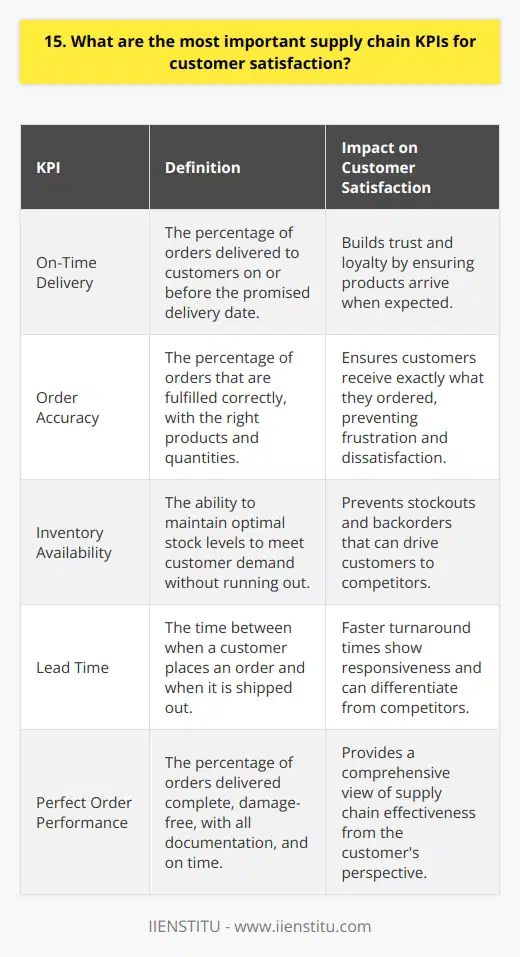
16. How do you benchmark your supply chain performance against industry standards?
When it comes to benchmarking supply chain performance against industry standards, I rely on a few key strategies. First and foremost, I stay up-to-date on the latest metrics and best practices in my field.
Tracking Key Performance Indicators
I regularly track KPIs like inventory turnover, order fulfillment rate, and transportation costs. By monitoring these numbers over time, I can see how our operations stack up to industry averages and identify areas for improvement.
For example, last quarter I noticed our inventory turnover had dipped below the industry median. I dug into the data and discovered we were holding onto excess safety stock. By adjusting our reorder points, we were able to free up working capital while still meeting customer demand.
Benchmarking Studies and Surveys
I also participate in benchmarking studies and surveys conducted by professional organizations and research firms. These provide valuable insights into how our performance compares to similar companies in terms of things like delivery speed, forecast accuracy, and supplier reliability.
A recent study revealed that our on-time delivery rate was in the top quartile for our industry. That was great news and a testament to the hard work of our logistics team. But the same study showed we had room for improvement in supplier scorecarding, so that's become a priority initiative.
Networking and Best Practice Sharing
Finally, I believe in the power of networking and best practice sharing. I regularly attend industry conferences and connect with supply chain leaders to swap ideas and learn from their successes and failures.
Last year at a logistics summit, I struck up a conversation with a exec who raved about how implementing a transportation management system had transformed their operation. That inspired me to spearhead a similar project at our company, which ended up reducing our freight spend by 15%.
So in summary, I use a combination of internal metrics tracking, external benchmarking data, and peer collaboration to continuously assess and elevate our supply chain performance. It's an ongoing journey, but one I find incredibly energizing and rewarding.
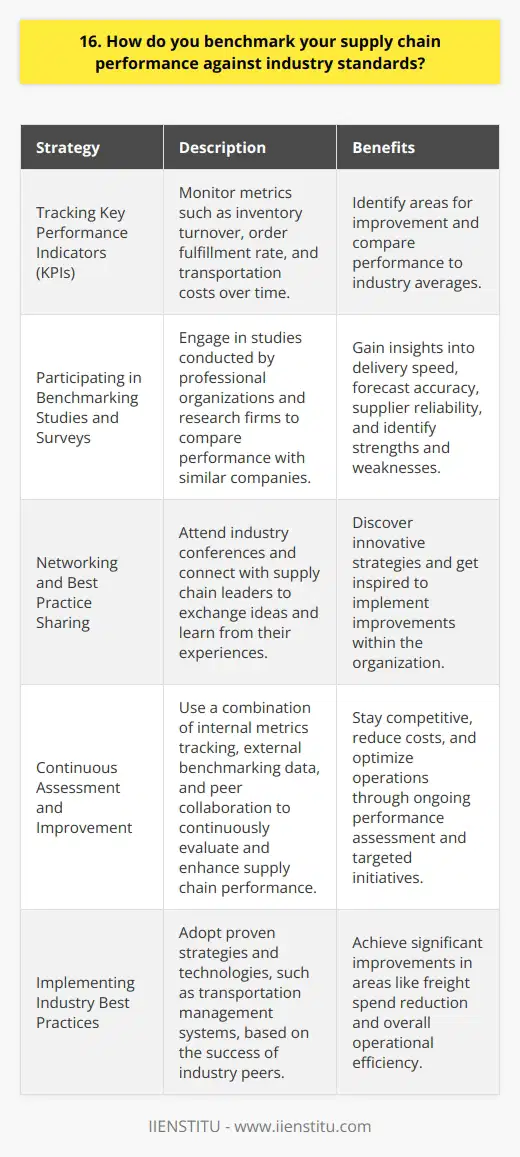
17. What are some strategies for improving underperforming supply chain KPIs?
To improve underperforming supply chain KPIs, I've found several strategies to be effective in my experience:
Identify Root Causes
The first step is to dig deep and identify the underlying reasons behind poor performance. This requires looking at data, processes, and talking with team members to uncover bottlenecks and inefficiencies.
Analyze Data
I like to analyze historical data to spot trends and anomalies. Key metrics to review include lead times, inventory levels, and order fulfillment rates.
Map Processes
Mapping out current processes can highlight unnecessary steps or delays. I've uncovered many improvement opportunities this way.
Collaborate with Stakeholders
Improving supply chain performance requires close collaboration with internal teams and external partners. Building strong relationships is crucial.
Communicate Regularly
I find that regular check-ins with suppliers and logistics providers helps identify and resolve issues faster. Weekly status calls are very useful.
Implement Improvements
Armed with data and insights, the next step is to implement targeted improvements. Some changes that have worked well for me:
Streamline Processes
Cutting out unnecessary steps, automating manual tasks, and paralleling activities can significantly reduce lead times and boost efficiency.
Optimize Inventory
Using demand forecasting models and setting appropriate safety stock levels helps minimize stockouts while avoiding excess inventory carrying costs.
By taking a structured approach to identify issues, collaborating closely with partners, and making data-driven improvements, I'm confident we can turnaround underperforming supply chain KPIs and deliver better results. It takes effort but I find it very rewarding to optimize these complex systems.

18. How do you ensure supply chain KPIs are aligned across different functions?
I ensure supply chain KPIs are aligned across different functions through several key strategies:
Collaboration and Communication
I foster regular communication and collaboration among various departments. This helps establish a shared understanding of goals and priorities. By bringing together teams from procurement, logistics, and operations, we can identify areas for improvement and ensure everyone is working towards the same objectives.
Defining Clear Metrics
I work with stakeholders to define clear, measurable KPIs that reflect our overall supply chain strategy. These metrics should be relevant to each function while contributing to the bigger picture. For example, procurement might focus on cost reduction, while logistics prioritizes on-time delivery. By aligning these KPIs, we create a cohesive framework for success.
Data Integration and Visibility
I advocate for integrated data systems that provide real-time visibility across the supply chain. When everyone has access to the same information, it's easier to make informed decisions and spot potential issues. I remember implementing a dashboard that displayed key metrics for each function, which greatly improved alignment and collaboration.
Continuous Improvement
Finally, I believe in fostering a culture of continuous improvement. By regularly reviewing KPIs and seeking feedback from all functions, we can identify areas for optimization. This iterative approach ensures that our supply chain remains agile and responsive to changing business needs. It's an ongoing process, but one that yields significant results when everyone is committed to shared goals.
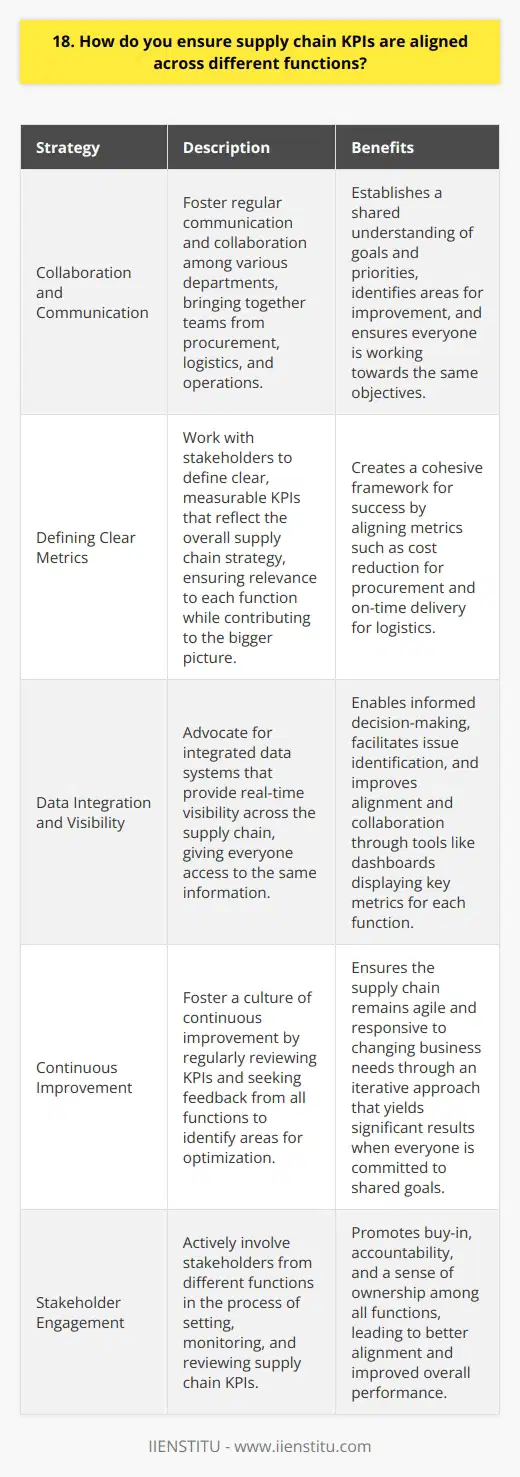
19. What are the key supply chain KPIs for measuring supplier performance?
As a supply chain professional, I believe that measuring supplier performance is crucial for maintaining a healthy supply chain. Over the years, I've learned that focusing on a few key performance indicators (KPIs) can make all the difference.
On-Time Delivery
One of the most important KPIs is on-time delivery. This measures how often suppliers deliver goods on the promised date. Late deliveries can cause production delays and unhappy customers, so it's essential to track this metric closely.
Quality
Another critical KPI is quality. I once worked with a supplier who consistently delivered subpar components, which led to costly rework and returns. By monitoring quality metrics like defect rates and customer complaints, you can identify and address issues before they spiral out of control.
Cost
Of course, cost is always a concern in supply chain management. I recommend tracking metrics like price variance and total cost of ownership. This helps ensure that you're getting the best value for your money and not overpaying for goods and services.
Responsiveness
Finally, I believe that responsiveness is an often-overlooked but essential KPI. How quickly does a supplier respond to inquiries and resolve issues? In my experience, suppliers who are proactive and communicative tend to be the most reliable partners.
By focusing on these key KPIs and regularly reviewing supplier performance, you can build a more resilient and efficient supply chain. It takes effort and collaboration, but the payoff is well worth it in my opinion.
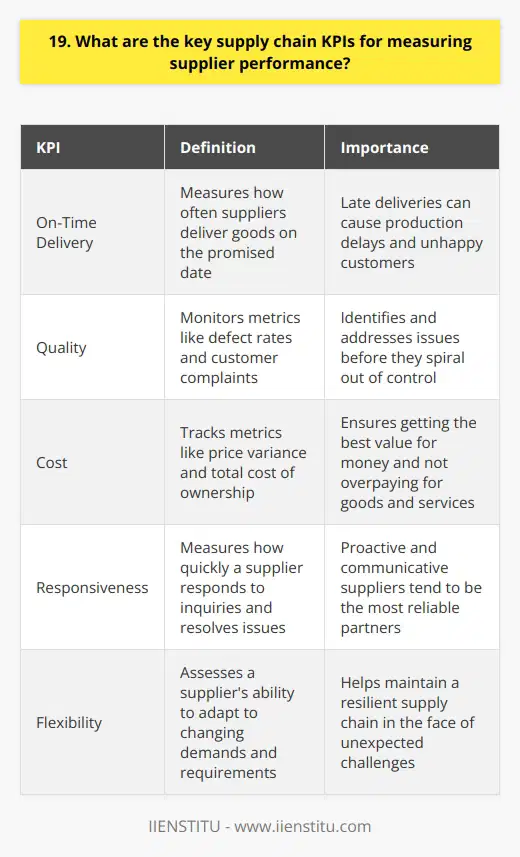
20. How do you use supply chain KPIs to drive continuous improvement?
I utilize supply chain KPIs to continuously improve processes and drive efficiency. By closely monitoring metrics like inventory turnover, lead times, and order fulfillment rates, I can identify areas for improvement.
Analyzing Data to Uncover Opportunities
I dig deep into the data to uncover trends and patterns. This helps me pinpoint bottlenecks or inefficiencies that may be holding us back. I remember one time when I noticed our inventory levels were creeping up, tying up cash flow.
Collaborating with Cross-Functional Teams
Once I spot an opportunity, I bring together key stakeholders from across the organization. By collaborating with purchasing, production, and logistics, we can brainstorm solutions and implement changes. It's all about fostering open communication and working towards a common goal.
Tracking Progress and Celebrating Wins
As we roll out improvements, I keep a close eye on the KPIs to gauge their impact. Seeing those numbers move in the right direction is incredibly motivating for the whole team. We make sure to celebrate our successes along the way, which keeps everyone engaged and invested in the process.
At the end of the day, I believe that supply chain KPIs are a powerful tool for driving continuous improvement. By leveraging data, collaborating with others, and staying focused on results, we can optimize our operations and deliver real value to the business.

21. What are some examples of how supply chain KPIs have driven business decisions?
In my previous role as a supply chain manager, I utilized various KPIs to drive business decisions. One example was the use of inventory turnover ratio to optimize stock levels and reduce holding costs. By closely monitoring this metric, we identified slow-moving items and adjusted our procurement strategies accordingly.
Improving On-Time Delivery
Another KPI that proved invaluable was on-time delivery percentage. By tracking and analyzing this metric, we identified bottlenecks in our distribution network and implemented process improvements. These changes resulted in a significant increase in customer satisfaction and reduced late delivery penalties.
Reducing Lead Times
Lead time was another critical KPI that influenced our decision-making. By collaborating with suppliers and optimizing our internal processes, we successfully reduced lead times for key raw materials. This allowed us to be more responsive to customer demands and improve our overall competitiveness in the market.
Enhancing Supplier Performance
Supplier performance metrics, such as quality and reliability, also played a crucial role in our decision-making process. By regularly assessing supplier KPIs, we identified top-performing suppliers and strengthened our partnerships with them. This led to improved product quality, reduced defects, and more efficient supply chain operations.
Throughout my career, I've witnessed firsthand the power of supply chain KPIs in driving business success. By leveraging these metrics strategically, we were able to optimize our operations, reduce costs, and enhance customer satisfaction. I believe that effective KPI management is essential for any organization looking to stay competitive in today's dynamic business landscape.

22. How do you determine the right frequency for measuring supply chain KPIs?
When determining the right frequency for measuring supply chain KPIs, I consider several factors. First, I look at the nature of the KPI itself. Some metrics, like inventory turnover, may require less frequent measurement than others, such as on-time delivery rates.
Aligning with Business Goals
I also align the measurement frequency with our business goals and objectives. If we're focusing on cost reduction, I might track certain KPIs more closely to ensure we're making progress.
Industry Benchmarks and Best Practices
Researching industry benchmarks and best practices helps me determine appropriate measurement intervals. However, I always adapt these to our unique supply chain dynamics.
Balancing Insight and Effort
It's crucial to strike a balance between gaining meaningful insights and the effort required to measure KPIs. I avoid measuring too frequently if it strains our resources or provides diminishing returns.
Continuously Reviewing and Adjusting
I believe in continuously reviewing and adjusting KPI measurement frequencies as our supply chain evolves. What worked well last year may not be optimal now, so I stay flexible and adapt as needed.
In my experience, finding the right KPI measurement cadence is an ongoing process that requires a blend of industry knowledge, business acumen, and a willingness to iterate based on results.
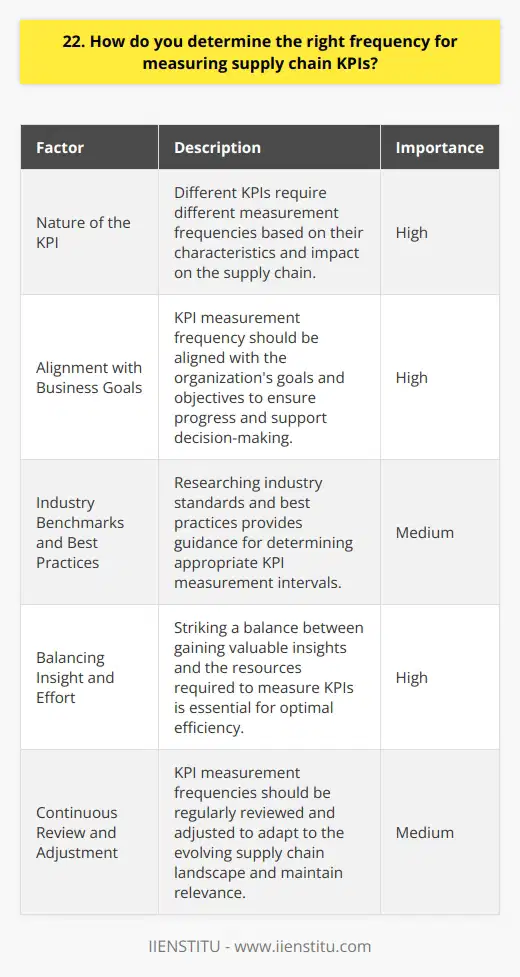
23. What are the most important supply chain KPIs for managing inventory?
When it comes to managing inventory effectively, there are several key performance indicators (KPIs) that I always keep in mind. Over the years, I've learned that focusing on these metrics can make a big difference in optimizing supply chain operations and reducing costs.
Inventory Turnover Ratio
One of the most critical KPIs is the inventory turnover ratio. This measures how quickly inventory is sold and replaced. A higher ratio indicates that products are selling fast, which is generally a good sign. I once worked with a company that had a low turnover ratio, and we implemented strategies to improve it, resulting in significant cost savings.
Days of Supply
Another important KPI is days of supply. This tells you how long your current inventory will last based on average sales. I recommend aiming for a balance - not too high, which ties up capital, and not too low, which risks stockouts. Finding the sweet spot takes some trial and error, but it's worth it.
Order Fill Rate
The order fill rate is a KPI that measures how often you can fill customer orders completely. A high fill rate leads to happy customers and fewer backorders. I once had to deal with a low fill rate situation, and it was stressful. We worked hard to improve our forecasting and inventory planning to get back on track.
Inventory Accuracy
Lastly, I always emphasize the importance of inventory accuracy. This KPI compares actual inventory levels to what's recorded in the system. Discrepancies can lead to all sorts of problems. I've found that regular cycle counts and good training for the warehouse team can help maintain high accuracy levels.
In my experience, focusing on these KPIs and continually monitoring and adjusting based on the data is the key to effective inventory management. It's not always easy, but the payoff in terms of efficiency and cost savings is well worth the effort.

24. How do you use supply chain KPIs to identify and mitigate risks?
I use supply chain KPIs to identify potential risks and take proactive measures to mitigate them. Here's how I approach it:
Monitoring Key Metrics
I keep a close eye on critical indicators like inventory levels, lead times, and supplier performance. By tracking these metrics, I can spot trends and anomalies that might signal upcoming issues.
For example, at my previous job, I noticed that our inventory turnover rate was steadily declining. This raised a red flag, so I dug deeper to find the root cause.
Conducting Root Cause Analysis
When I identify a potential risk, I don't just treat the symptoms - I aim to uncover the underlying factors. In the case of the declining inventory turnover, I discovered that our main supplier was experiencing production delays due to equipment breakdowns.
Developing Contingency Plans
Once I understand the risks, I work with my team to create contingency plans. We might explore alternative suppliers, adjust our safety stock levels, or redesign our processes to build in more resilience.
In the inventory turnover scenario, we decided to diversify our supplier base and implement a more robust inventory management system. These steps helped us mitigate the risk of future disruptions.
Continuous Improvement
I believe in the power of continuous improvement. I regularly review our KPIs and risk mitigation strategies to see what's working and what could be better. It's an ongoing process of learning and adaptation.
By staying vigilant, proactive, and adaptable, I've been able to identify and manage supply chain risks effectively in my previous roles. I'm confident I can bring the same approach to this position and help strengthen the resilience of our supply chain.

25. What are some best practices for visualizing supply chain KPI data?
When visualizing supply chain KPI data, there are several best practices to keep in mind. In my experience, these strategies can make a big difference in how effectively you communicate insights and drive decision-making.
Choose the Right Visualizations
Select chart types that best fit the data and message you want to convey. I've found that using a mix of bar charts, line graphs, and heat maps helps provide a comprehensive view of supply chain performance.
Keep It Simple
Avoid clutter and excessive details that can obscure the main points. Stick to clean, easy-to-read designs. When I create dashboards, I aim for a minimalist look that puts the data front and center.
Highlight Key Metrics
Identify the most critical KPIs and give them prominence in your visualizations. I like to use color coding and placement to draw attention to important metrics like inventory turns, on-time delivery rates, and cost per unit.
Provide Context
Include benchmarks, targets, and historical data to give meaning to the numbers. Seeing how current performance compares to past results and goals helps users interpret the data. I always try to incorporate this contextual information.
Make It Interactive
Allow users to explore the data through filters, drill-downs, and hover-over details. Interactivity empowers people to find answers to their specific questions. I love designing dashboards that invite engagement and discovery.
By following these practices, you can create supply chain visualizations that are both informative and impactful. The key is striking a balance between simplicity and depth to tell a compelling data story.
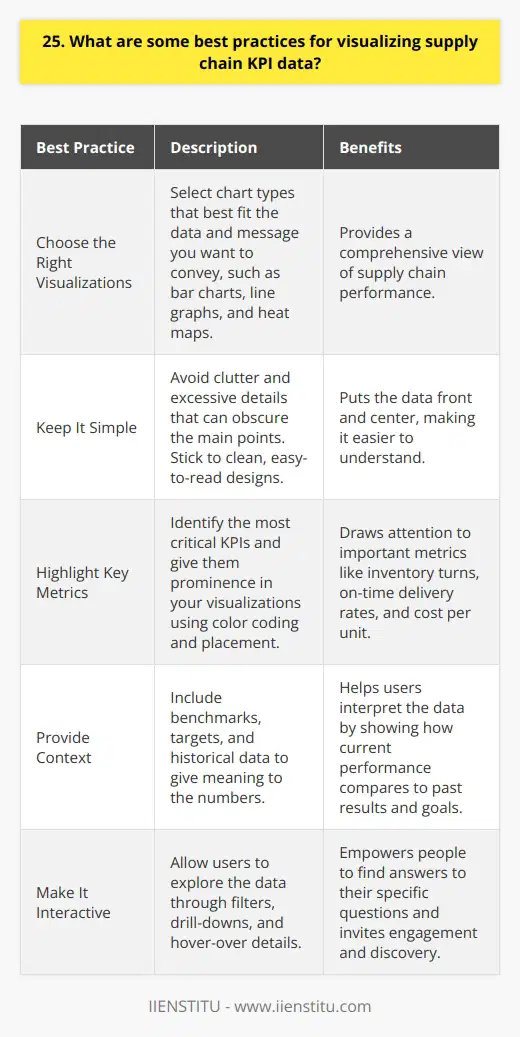
26. How do you ensure buy-in from all stakeholders when implementing supply chain KPIs?
Ensuring buy-in from all stakeholders when implementing supply chain KPIs is crucial for success. I've found that clear communication and collaboration are key.
Understand Stakeholder Needs
First, I take the time to understand each stakeholder's unique needs and goals. What matters most to them? I listen closely and ask questions to gain a deep understanding.
Align KPIs with Objectives
Next, I work to align the proposed KPIs with the overall objectives of the organization and each stakeholder. I explain how tracking these metrics will help us achieve our shared goals.
Demonstrate Value
I strive to clearly demonstrate the value that the KPIs will provide. Whether it's reducing costs, improving efficiency, or mitigating risks, I highlight the tangible benefits we expect to gain.
Involve Stakeholders in the Process
Throughout KPI development and implementation, I actively involve stakeholders. I seek their input, listen to their concerns, and incorporate their feedback. People are more likely to support initiatives they helped shape.
Regular Updates and Transparency
I commit to providing regular updates on our progress and being fully transparent. Stakeholders should never feel in the dark. I share both successes and challenges along the way.
Continuously Improve
Finally, I emphasize that implementing KPIs is an ongoing process. As we learn and conditions change, we can refine and improve our approach. Flexibility and continous improvement help maintain stakeholder engagement over time.

27. What are the key supply chain KPIs for measuring transportation performance?
When measuring transportation performance in a supply chain, there are several key KPIs to consider. These metrics provide valuable insights into the efficiency and effectiveness of your transportation operations.
On-Time Delivery (OTD)
OTD measures the percentage of shipments delivered on or before the promised delivery date. It's a critical metric for customer satisfaction and loyalty. I once worked with a company that struggled with late deliveries, causing frustration among clients. By focusing on improving OTD through better route planning and communication with carriers, we significantly enhanced customer relationships.
Transportation Cost as a Percentage of Sales
This KPI helps you understand the impact of transportation costs on your bottom line. It's essential to strike a balance between cost optimization and service quality. In my experience, regularly reviewing carrier contracts, optimizing routes, and consolidating shipments can lead to substantial cost savings without compromising delivery performance.
Carrier Performance
Monitoring carrier performance is crucial for ensuring reliable and efficient transportation. Key metrics include on-time pickup and delivery rates, damage rates, and communication responsiveness. I recommend establishing clear performance expectations with carriers and regularly reviewing their performance to identify areas for improvement. Building strong partnerships with top-performing carriers can greatly enhance your transportation operations.
Inventory Days of Supply
This KPI measures how long your inventory lasts before needing replenishment. Optimal inventory levels minimize carrying costs while preventing stockouts. I've found that collaborating closely with suppliers, using data-driven forecasting, and implementing just-in-time inventory strategies can help optimize inventory days of supply and improve overall supply chain efficiency.
Remember, the specific KPIs you prioritize may vary depending on your industry and business goals. Regularly monitoring and analyzing these metrics will provide valuable insights for continuous improvement in your transportation performance.
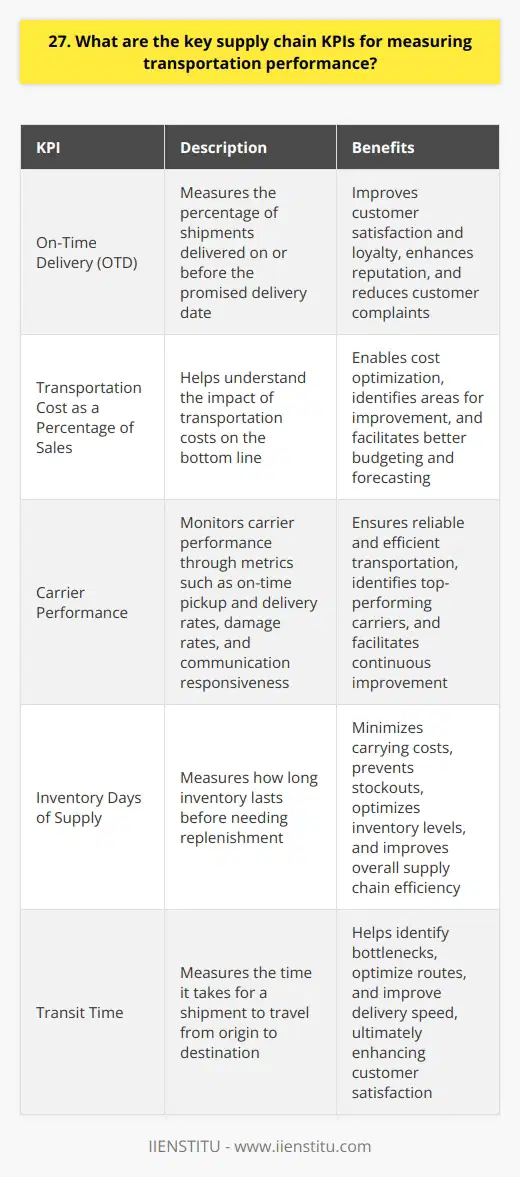
28. How do you use supply chain KPIs to optimize resource allocation?
I use supply chain KPIs to optimize resource allocation by first identifying the most critical metrics for our business. These typically include inventory turnover, order fulfillment rate, and transportation costs.
Analyzing KPIs
Once I have the key KPIs, I dive deep into the data to understand trends and patterns. I look for areas where we're underperforming or overspending.
For example, last year I noticed our inventory turnover had slowed down significantly in certain product categories. This tied up working capital and increased holding costs.
Collaborating with Stakeholders
Armed with insights from the KPIs, I collaborate with cross-functional teams to develop optimization strategies. This involves working closely with procurement, logistics, and sales.
Together, we brainstorm ways to streamline processes, reduce waste, and allocate resources more efficiently. It's a team effort that requires open communication and creative problem-solving.
Implementing Changes
After aligning on a plan, I take the lead in implementing the necessary changes. This might include renegotiating contracts with suppliers, adjusting safety stock levels, or redesigning distribution networks.
I closely monitor the impact of these changes on our KPIs. If something isn't working, I'm not afraid to pivot and try a different approach.
Continuous Improvement
Optimizing resource allocation is an ongoing process. I'm always looking for ways to fine-tune our supply chain and drive better performance.
By staying proactive and data-driven, I've been able to consistently improve our KPIs and create value for the business. It's challenging work, but also incredibly rewarding.
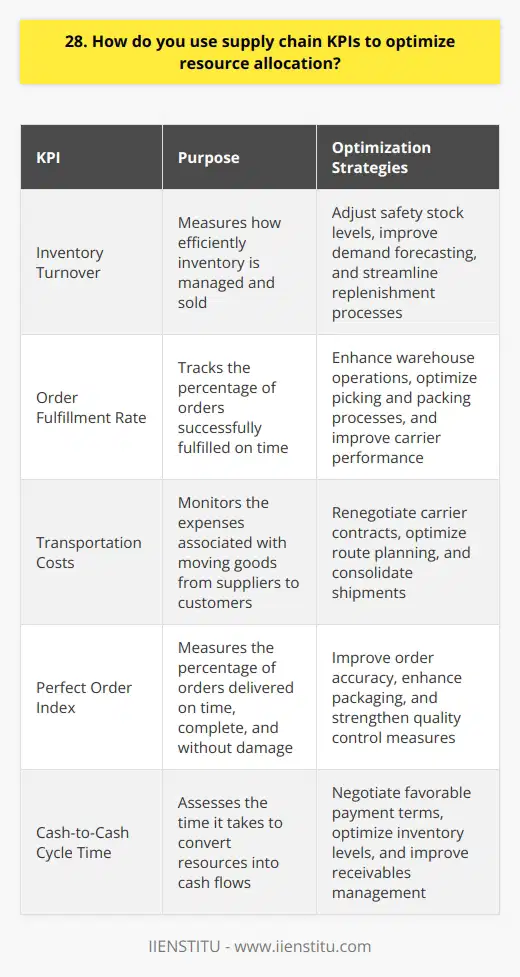
29. What are some strategies for aligning supply chain KPIs with sustainability goals?
Aligning supply chain KPIs with sustainability goals requires a holistic approach. I've found that collaboration is key. Engage stakeholders across the organization to identify shared objectives and metrics.
Define Clear Sustainability KPIs
Establish specific, measurable sustainability KPIs that align with your company's values and goals. These might include reducing carbon emissions, minimizing waste, or sourcing responsibly. Choose indicators that are relevant and achievable.
Integrate Sustainability into Supplier Selection
When choosing suppliers, consider their sustainability practices alongside traditional criteria like cost and quality. Prioritize partners who demonstrate a commitment to environmental and social responsibility. This can help ensure alignment throughout the supply chain.
Monitor and Report Progress
Regularly track and report on your sustainability KPIs. Share progress with internal and external stakeholders to maintain accountability. Celebrate successes and identify areas for improvement. Transparency builds trust and motivation.
Foster a Culture of Sustainability
Embed sustainability into your organization's culture. Engage employees through training, communication, and incentives. Encourage innovative ideas that support sustainability goals. When everyone is on board, aligning KPIs becomes more natural.
Continuously Improve and Adapt
Sustainability is an ongoing journey. Regularly review your KPIs and adjust as needed. Stay informed about industry best practices and emerging trends. Collaborating with suppliers, customers, and other partners can spark new ideas and efficiencies.
Remember, aligning supply chain KPIs with sustainability takes time and effort. But in my experience, it's worth it. Not only is it the right thing to do, but it can also lead to cost savings, risk reduction, and a positive brand reputation.

30. How do you continuously evolve and adapt supply chain KPIs to changing business needs?
As a supply chain professional, I continuously evolve and adapt KPIs to align with changing business needs. Here are some strategies I use:
Stay Connected to Business Objectives
I make it a priority to deeply understand our company's goals and how they evolve over time. By staying connected to the big picture, I can identify when supply chain KPIs need to shift to better support those objectives.
Example:
Last year, our focus moved from cost reduction to improving customer satisfaction. I worked with my team to adjust our KPIs, putting more weight on metrics like on-time delivery and order accuracy.
Regularly Review and Reassess
I schedule periodic reviews to critically assess if our current KPIs are driving the right behaviors and outcomes. If something isn't working, I'm not afraid to make changes.
Example:
In one case, we realized our inventory turnover KPI was causing stock-outs. We adjusted the target to strike a better balance between efficiency and service levels.
Collaborate with Stakeholders
Adapting KPIs isn't a solo effort. I actively seek input from colleagues in sales, finance, operations, and other areas to understand their needs and get buy-in.
Example:
When our sales strategy shifted to smaller, more frequent orders, I met with the sales leaders to discuss how we could update KPIs to enable this approach while still maintaining efficiency in the supply chain.
Ultimately, evolving supply chain KPIs is about staying closely aligned with the business, being proactive in measuring what matters, and collaborating to drive the best possible results.
